Baby's daily routine at 7 months
Let us immediately clarify that this regimen is only approximate, indicative, it is very similar to the daily routine of a 6-month-old child. Parents, first of all, need to rely on the individual characteristics of the baby. It is advisable for every mother to create a daily routine on her own, taking into account the characteristics of the character and physiological development of her baby.
If the drawn up routine is suitable, then the child will be happy to play, actively walk and communicate in “his” language, he will be cheerful and healthy. And most importantly, the hours of feeding and sleep will completely coincide with his biorhythms and needs.
So, this daily routine table is offered as an example and to help. After all, the main points should still be the same. In the first place - good nutrition and sleep.
| 7.00-7.30 | First breakfast time for all infants (both those on IV and those on breastfeeding) |
| 7.30-8.30 | Period of wakefulness. We do massage, hygiene procedures, change clothes. |
| 8.30-10.00 | The period of the first daytime sleep. The child may miss it. |
| 10.00-10.30 | Lunch. Light milk porridge and fruit puree are recommended. |
| 10.30-12.00 | Walk. Try to go out into the fresh air, communicate, take an active walk. If the weather does not allow, the baby can play in the playpen or with his parents. |
| 12.00-13.30 | Daytime sleep period. It’s a good idea to put your baby to bed in the fresh air (if possible). |
| 13.30-14.00 | Dinner. It should be filling and include a variety of dishes. |
| 14.00-16.00 | Walk outdoors or play at home. |
| 16.00-18.00 | Afternoon nap period. |
| 18.00-18.30 | Time for dinner. |
| 18.30-20.30 | In the warm season, walk outside, in bad weather or in winter, play and communicate with family at home. |
| 20.30-21.00 | You can devote time to air baths if the baby is healthy and active. |
| 21.00-21.30 | Bathing in an adult bath. |
| 21.30-22.00 | Relaxing massage, communication with mom, getting ready for bed. |
| 22.00-22.30 | The period of night sleep begins. If the child gets up at night, then give him some water to drink (if he is bottle-fed, if he is breastfed, the best sedative is his mother’s breast). |
Try to notice when your baby becomes sleepy and active. At 7 months, it can already be quite difficult to put your baby to bed strictly according to the clock. Therefore, do not insist, show maximum patience if the baby does not fall asleep. Use your imagination: perhaps the child is soothed by certain calm music, or he sleeps well in the fresh air.
Try to develop your own routine that makes your baby comfortable. If the daily routine slightly differs from the proposed table, the advice of a pediatrician or the recommendations of the older generation, then it’s okay. Over time, everything will get better, you just need to stick to the basic rules.
Getting used to the routine of a seven-month-old baby
Baby's daily routine at 9 months
If before the child was 7 months old, he did not have an established daily routine, but the parents decided that the time had come and it was time to learn to live according to a schedule, you should be patient. The process will take some time, it is not a matter of one day.
First of all, it is necessary to determine what the child's needs are. This includes feeding 4-5 times a day, hygiene procedures, a walk 1-2 times a day, educational games with the child, naps during the day (2-3 times a day), bathing before bed, night sleep (6-8 hours).
Regimen of a 7 month old baby on breastfeeding
- 6.00-8.30 - awakening, first feeding (breast milk), morning hygiene procedures, air baths;
- 8.30-10.00 - morning sleep;
- 10.00-12.00 - afternoon snack (complementary feeding), gymnastics, strengthening massage;
- 12.00-14.00 - walk in the fresh air, sleep on the street;
- 14.00-16.00 - feeding (complementary feeding), active educational games;
- 16.00-18.00 - walk, sleep;
- 18.00-21.00 - feeding (breast milk), communication, games;
- 21.00-21.30 - swimming before bed;
- 21.30-22.00 - feeding at night (breast milk);
- 22.00-6.00 - night sleep.
Child mode on IV at 7 months
- 6.00-8.30 - awakening, first feeding (baby formula), morning hygiene procedures, air baths;
- 8.30-10.00 - morning sleep;
- 10.00-12.00 - afternoon snack (complementary feeding), gymnastics, strengthening massage;
- 12.00-14.00 - walk in the fresh air, sleep on the street;
- 14.00-16.00 - feeding (complementary feeding), active educational games;
- 16.00-18.00 - walk, sleep;
- 18.00-21.00 - feeding (solid feeding), communication, games;
- 21.00-21.30 - swimming before bed;
- 21.30-22.00 - feeding at night (milk formula);
- 22.00-6.00 - night sleep.
The daily routines of a 7-month-old breastfed and bottle-fed baby differ only in nutrition, otherwise the needs of children are similar, and there are no fundamental differences.
Differences in the daily routine of breastfed and bottle-fed children
Undoubtedly, they exist. After all, it is important not only what kind of milk formula you give your child, but also how his body copes with such food. If a child's breastfeeding is the main source of satiation, then in this case the daily routine may be more free. It all depends on the baby’s natural desire to stay near the breast, to calm down, and not just to eat.
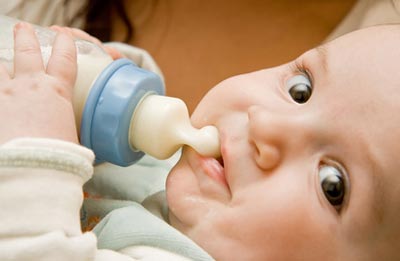
For breastfed babies, everything is based on instincts; for bottle-fed babies, everything depends on the feeling of hunger and satiety.
Features of infant formula and breast milk
- Formula-fed babies are fed less frequently, as a certain amount of formula is given. Mom sees how much the child has eaten. If the baby eats everything on time, then he sleeps more calmly.
- For breastfed babies, everything is more complicated. Much depends on the fat content of mother's milk. In some cases, the baby does not get enough to eat, so you have to put it to the breast more often. For this reason, night feedings may continue.
- Formulas take a longer time to digest, since they are based on casein, which is digested more slowly by the child’s digestive system. Whey protein is contained in the mixture in a smaller composition, but it is also absorbed faster.
- Breast milk, on the contrary, contains less casein and more whey protein, so digestion is more accelerated.
- However, bottle-fed babies may wake up at night to eat. Should be fed. In this case, there is no need to focus on the schedule. The main thing is the needs of the child. Perhaps the baby is very active, and his calories are consumed quickly.
Should you pay attention to your baby's stool?
- Definitely yes. Because for “artificial” people the digestion process occurs differently. The appearance of the stool directly depends on what the child was fed.
- If the child was on breastfeeding, and then there was not enough milk, and he had to be fed with formula, then get ready for the baby’s digestive system to be rebuilt for some time. Accordingly, periods of sleep and wakefulness can be shifted.
- Particular attention should be paid to sterilizing bottles. Under no circumstances should the mixture be left, as various pathogenic bacteria may develop in it.
- If a baby on breastfeeding does not go to the toilet “in a big way” for a couple of days, then there is nothing wrong with that: it means his body completely absorbs the milk.
- A bottle-fed baby is another matter. There should be daily bowel movements. If the baby’s diet is not suitable, then constipation is possible, and hence restless sleep and moodiness.

Allergies and colic
- Children who are weaned to the breast may develop allergies or colic if the mother eats foods that are too fatty, spicy or salty, or a lot of red vegetables or fruits.
- Formula-fed babies generally respond well to adapted milk porridges. But colic and allergic rashes are common. In this case, the child’s routine may be disrupted.
In both cases, if the baby’s composition is suitable for mother’s milk or formula, his digestive system copes, then the daily routine does not get disrupted. Then the child is full, feels good and sleeps well both at night and during the day.
If something is not suitable, for example, fat content or, conversely, there are not enough calories, then the baby is restless, sleeps poorly, and is capricious. This, without a doubt, affects the daily routine.
Diet
The basis at this age, as in 6-month-old children, is still breast milk or an adapted formula. But, starting from 6–7 months, the child is introduced to complementary foods, gradually adding new dishes. Everything is very individual. Some children are happy to start eating adult food, and some take different types of food on the second try.

In any case, it is necessary to observe the reaction of the baby’s body and take into account his wishes.
If he is not ready for meat or yolk, then there is no need to force him. Start a little later. If you see that your baby is happy to try new dishes, then introduce him to food gradually, starting with a very small dose. Baby's menu at 7 months (1 day)
| Meal hours | Breastfed (food composition and quantity) | On artificial feeding (composition and amount of food) |
| 6.00 (7.00) | Breast milk (you can give a little extra kefir) | AMC (adapted milk formula) – 180 – 190 ml + kefir |
| 10.00 |
|
|
| 14.00 |
|
|
| 18.00 |
|
|
| 22.00 | Breast milk or kefir | AMC – 180 – 210 ml or kefir |
What foods can be given to a 7 month old baby?
Let's take a closer look at what set of products is recommended for a baby at this age. And most importantly, how to feed correctly and what kind of nutrition will be appropriate and healthy?
Vegetable puree
- It is better to steam vegetables. This way, the maximum amount of nutrients remains.
- Prepare vegetables of the same color and monocomponent. This will help in case of an allergic reaction to determine exactly which ones should be discarded and which ones should be replaced.
- The most acceptable ones would be zucchini, cauliflower or broccoli.
- Vegetables are usually processed in a double boiler for no more than half an hour (20 - 25 minutes).
- There is no need to add salt, as the child senses taste more subtly. The amount contained in cabbage or other fruit is enough for him.
- Vegetable oil is also not added - the child receives the required amount of fats along with mother's milk or from formula.
- Only for children from 8 months of age it is recommended to add 2-3 drops of vegetable oil to the puree, and butter even later for several months. Oil is an additional burden on the child’s stomach.
- Boiled vegetables should be pierced well with a toothpick or match if they are ready.
- Next, they need to be pureed using a blender. The baby cannot chew solid food yet. Therefore, there should be no lumps in the puree.
- The puree is diluted with pre-prepared water or broth from cooked vegetables.

Important: only 2 components are allowed: one vegetable and water at one feeding!
Fruit puree
- It is recommended to start feeding with fresh fruits: apples, pears or bananas. Choose green or yellow color, as they will definitely not cause allergies. Red and orange fruits are best left for a later period. This is especially true for children who have digestive problems or have a pronounced tendency to allergies.
- As with vegetable puree, only 1 component can be given per meal, that is, 1 apple, 1 pear and 1 banana.
- The fruit is peeled and cored, divided into pieces and ground in a blender until liquid. A small amount of water is added to the banana puree to prevent the baby from choking.
- No sugar added! All the substances, including sweetness, are contained in the fruit. Sugar (especially refined sugar) will only harm the child.
- Fruit puree can be diluted a little with water and served only freshly prepared.

Kefir
Some pediatricians, including the famous Dr. Komarovsky, recommend starting complementary feeding with fermented milk products. They are closer to breast milk and are easiest to digest and do not put much strain on the stomach.
But it is important to know that purchased products can be dangerous to the baby’s health. Various preservatives, flavorings, etc. are added there. It is more advisable to make kefir yourself, using special starter cultures, or purchase a special product from a children's dairy kitchen.

It is advisable to buy milk for kefir at an eco-shop or negotiate with a farm. In any case, it must be a 100% natural product, the quality of which you must be sure of.
Meat
- Try starting to introduce this product. Only lean varieties are suitable: beef, veal, turkey, chicken or rabbit. They are rich in vitamins B, B12 and A, as well as iron.
- Let's just have the broth. Especially at the beginning of complementary feeding. Let's have vegetable soup with meat a little later.
- If your baby uses store-bought purees, then carefully look at the manufacturer, expiration dates, composition and age restrictions.
- When you first start trying, give a very small dose. And during the first 24 hours, watch the child’s reaction. If everything is fine, then gradually increase the dosage.
Yolk
- We are talking only about the yolk, since the white is a fairly allergenic product.
- The yolk contains phosphorus and iron, unsaturated fatty acids, carotene and vitamins A and E.
- Regardless of what kind of bird eggs you are going to give, chicken or quail, they must be thermally processed! Raw eggs can contain salmonellosis, which can affect absolutely all birds.
All new products must be fresh and prepared immediately before use. If the baby flatly refuses adult food, then the body is not ready yet.
When, when weighed, it turns out that weight is gained within the normal range, it is simply too early to feed, and the child has enough nutrients taken from milk or formula.
If your child is prone to allergies, try new dishes very carefully. Consult your pediatrician.

Wanting to help the baby and forcibly stuffing him with food, parents often only bring harm. The diet should be selected taking into account the individual characteristics of the children’s body.
Caring for a 7 month old baby
In order for the baby to develop comprehensively not only physically, but also psychologically, he needs the attention, love and affection of his parents. Tactile contact is no less important than proper nutrition and adherence to the regime, so the child needs stroking, massage, and joint games with his mother.
Exercise and massage
At 7 months, the baby begins to actively crawl, roll over from back to sides and stomach, spending almost all of his waking time in motion. At this stage, it is important to maintain proper muscle tone, perform physical exercises and massage the child. This will help prevent fatigue, prepare the baby's body for increasing loads and reduce tension on muscle groups.
In the morning, it is advisable to do a warm-up - bend your knees, spread your baby's arms to the sides, massage the tummy. In the evenings, after bathing, a general massage with soft oil will help the child fall asleep peacefully, fully relax and absorb all the information accumulated during the day.
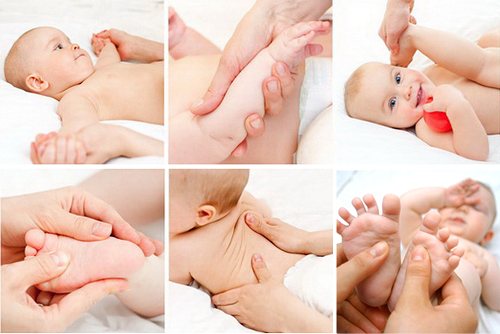
Bathing
Washing procedures are carried out with the baby every morning, cleaning his face, arms and legs with boiled water, and then wiping with a soft towel. Bathing is carried out daily, as it is a complete hygienic procedure, a way to relax the muscles after an active day and calm the nervous system.
A child of 7 months can already bathe in an adult bathtub, but a towel or folded sheet should be placed at the bottom to prevent it from being slippery. Parents should be nearby and monitor the safety of the procedure. The average bath duration is 15-20 minutes, but if the baby likes to bathe, you can extend the time by another 5-10 minutes. In the bath, you can use rubber balls, buckets, toys; the mother should play with the baby while bathing so that the physical and psychological development of the baby is complete.
Sleep: how much sleep should a seven month old sleep?
At this age, the child often switches to a new daytime sleep schedule. Some are still sleeping 3 times, but many are already moving to 2 periods of sleep.
- If you notice that your baby is switching to a two-phase sleep pattern, then rearrange your daily routine. In this case, put the child to bed before lunch from 11.00 to 12.30, and after lunch from 16.00 to 17.30. Then the total duration of sleep is already different (11 hours) from the duration of sleep of children who have not yet readjusted. They sleep another 13 hours. For those who start sleeping twice, they are awake longer than they are asleep.
- Some children sleep for only 50 minutes or 1 hour in the morning and evening, but their daytime sleep takes them 2 to 3 hours. In general, children sleep well outside, so you can sleep during the day in a stroller and at the same time breathe fresh air.
- There is no need to force the child to lie down. At this age, such changes are absolutely normal. Don't try to return to your normal routine. The baby himself will tell you when and how much sleep is best, watch his condition.

In native mode
Whether it is worth building a daily routine for your baby or not is only your decision. However, in addition to all the positive aspects that affect the child’s development, the regime also helps you. After all, you can plan your affairs in advance and build your own personal daily routine. In addition, at this age it is very difficult for children to switch from play to relaxation due to a poorly developed nervous system. As a result, quite often children can demonstrate fatigue by being very overexcited. It is at such moments that the help of a parent is needed, who will calm the baby and give him the opportunity to rest.

Child development
At seven months of age, the baby enters the second half of his life. He actively plays, develops, sleeps less and is awake more, tries new food and explores the world around him with all his might, not only trying to get his hands on everything, but also to try it out. Therefore, parents need to be on guard all the time. All dangerous objects must be hidden away.
The table below is an example only.
Don't forget that small deviations are the norm. But if you are concerned about obvious delays in height or weight, the child is restless, sleeps and eats poorly, then do not delay your trip to the pediatrician. Only his consultation will help determine the cause. Physical development of a child at 7 months
| Options | Girls | Boys |
| Height, cm | 63 – 72 | 65 – 73,5 |
| Weight, kg | 6,2 – 9,8 | 7,0 – 10,3 |
| Head circumference, cm | 40,2 – 45,5 | 41,5 – 46,5 |
| Chest circumference, cm | 42 – 47,2 | 42,5 – 49 |
What can a baby do?
- Sits independently, without support from adults. He sits on his own for quite a long time.
- He begins to try to crawl, but it is still difficult to support his body weight in his arms.
- When the baby lies on his stomach, he takes light and small objects with one hand and leans on the other.
- Turns over quickly on its own. During this period of the first bruises, parents should not leave the baby alone for a minute, especially on a high bed. The baby's movements are still uncoordinated and awkward.
- The child drinks from the bottle himself and regulates the process.
- Can stand up on his feet in the crib and squat. The sides serve as support.
- With support, he moves his legs under his arms and tries to walk.
- A separate topic is teeth and their eruption. Some children already have 2 of them, others don’t have any yet. There is no reason to worry, as teeth should appear before one year. Everyone has an individual schedule.
The main indicators of teething are excessive drooling, moodiness, increased body temperature to 37 - 38 degrees, sleep disturbance, swelling of the gums, and lack of appetite. The child puts everything into his mouth and touches his face and ears.
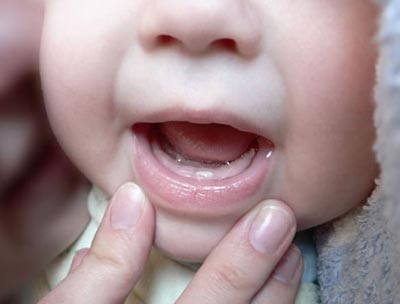
At this time, parents need to show maximum patience, since painless appearance of teeth is rare. Sleepless nights usually begin, and accordingly, the daily routine can completely shift.
Mental development
- The baby knows his name and understands when his name is called.
- Recognizes everyone who plays with him or is often near him. He worries and even cries when he does not see his family for a long time.
- The babbling period begins, the baby points to toys, bright objects, animals and people.
- The baby understands intonation, severity and affection. Willingly goes into the arms of loved ones, but may repel strangers.
- Usually, at this age, the right hemisphere is actively developing, so the child uses his left hand more. It is not at all necessary that a son or daughter will be left-handed; this period is short-lived and any conclusions are premature.
- At this time, the baby may be frightened by too loud sounds. They disturb and bring discomfort. Try not to turn on a vacuum cleaner or other “noisy” household appliances, as well as loud music.
Baby's daily routine at 7 months
Your baby is very big, he is already 7 months old and has learned a lot. To make it easy for you to cope with all the difficulties of sleep at this age, and to establish a baby’s daily routine at 7 months, read our article and be sure to watch all the recommended videos.
Features of age
— Children in the 8th month of life are very mobile. They learn to sit down, crawl, and stand up. All of these skills require your brain to work hard, and everything around you becomes available for exploration.
— Sleep moves to the last place in the child’s sphere of interests.
The baby is preoccupied with new tasks, training his skills and analyzing new impressions - in this state it becomes difficult and boring for him to sleep.
- During this period, sleep regression is very likely. The child resists falling asleep, sleeps little and restlessly, the usual daily routine falls apart and is accompanied by significant changes in the routine. Regression is especially acute if, in addition to the general excited state associated with a developmental leap, unpleasant sensations from teething or a suddenly aggravated fear of separation from the mother are added.
Sleep standards
Children grow up and become more and more awake. Babies sleep less and less during the day and longer at night. Some babies can already sleep through the night without feeding.
7-month-old babies need 13-16 hours of sleep per day, of which:
— 10-12 hours at night
— 3.5 hours in the afternoon
Children sleep 3 times during the day, the 3rd sleep is short and inconsistent.
Wake Time
Comfortable waking time for a 7 month old baby is 2:15 – 3:30 hours.
It is very important for parents to spend their waking hours “correctly”, to maintain a balance of active and calm wakefulness. So that the baby is ready for bed:
— fairly tired, but not overtired (compliance with WB)
- calm, not overexcited (calm VB or slowing down)
- relaxed (ritual)

Example of a regimen for a 7 month old baby
The child's daily routine at 7 months is established. The routine should be designed so that the baby does not stay awake for too long. A 7 month old child's waking hours do not exceed 3 hours.
Getting up from 6 to 7.30 am and going to bed at night from 19:00 to 20:30 is recorded. 2 daytime naps of 1.5-2 hours each are maintained. As a rule, after morning sleep, daytime sleep stabilizes. A convenient time for daytime sleep is between 12:30 and 14:00. Daytime sleep should be deep enough to restore the baby's physical strength. Therefore, for daytime sleep, silence, darkness and lack of movement are most critical, so as not to disturb the slow phase of sleep, which promotes the regeneration of strength.
A 3rd additional nap is possible, which helps the baby survive until the evening if the 2nd nap ends too early. The 3rd nap is short, “quick” and less demanding on sleep conditions - it can be organized in a car or stroller. The 3rd nap should end at least 2-3 hours before bedtime, otherwise there will be problems with going to bed on time for the night.
“Flickering” 3rd daytime nap 45-60 minutes, as a rule, it goes away completely by 9 months. But starting from 5-6 months, the child can do without this sleep if he slept well the previous 2 naps during the day and goes to bed on time in the evening. The 3rd nap should be completely abandoned if after it it becomes difficult to put the child to bed at night. In this case, it is better to shift your bedtime for the night 30-60 minutes earlier.
1-2 night feedings are still necessary. Complementary feeding is already complete nutrition and meals become part of the child’s daily routine at 7 months.
Approximate daily routine for a 7 month old baby:
| Time | Action |
| 7.00 | Lifting, feeding |
| 7.15 | Rituals for awakening |
| 7.35 | Cooperative games |
| 8.00 | Breakfast |
| 8.25 | Standalone game |
| 8.40 | Getting ready for bed, rituals |
| 9.00 | The beginning of the first dream |
| 10.30 | Waking up, feeding |
| 11.20 | Walk |
| 12.10 | Feeding, rituals |
| 12.40 | The beginning of the second dream |
| 14.10 | Waking up, feeding |
| 14.30 | Joint active games |
| 14.50 | Standalone game |
| 15.10 | Speech development games |
| 15.40 | Massage, gymnastics |
| 16.00 | Feeding, rituals |
| 16.20 | Beginning of the third sleep (sleep can be arranged in the stroller) |
| 17.00 | Waking up, feeding |
| 17.15 | Stimulation of physical activity |
| 18.00 | Standalone game |
| 18.20 | Quiet games with dad |
| 18.40 | Bathing |
| 19.00 | Feeding, rituals |
| 19.30 | Start of night sleep |
Sleep patterns at 7 months
The main feature of sleep at 7 months is the “flickering” 3rd day sleep:
- inconsistent short sleep (45 minutes) in the afternoon (from 15-17:00)
- is optional and very much depends on what the first 2 daytime sleeps were like - in duration and quality.
This happens because as the baby grows, his need for daytime sleep decreases. The older the child, the less he sleeps during the day.
From 6-9 months, the need for a 3-day nap subsides. For some children, the transition to a schedule with fewer daytime naps is painless; for some, this transition period is accompanied by overwork and disruption of the routine.
To make the decision to reduce the number of naps and switch to a 2-nap schedule, pay attention to the following signs of readiness for the transition.
- 3rd dream interferes with night sleep:
- due to the third daytime nap, the time for going to bed at night is shifted to a later time (later 20:00);
- going to bed at night takes longer than usual, with resistance from the child;
- increased number of night awakenings
- The 3rd dream affects daytime dreams:
- morning and afternoon naps have decreased in time
- difficulty getting into bed for naps during the day
— 3rd nap lasts 30 minutes and starts later than 16:30
If you have been observing these signs in your baby for at least 3-5 days, you can begin gradually changing your baby's routine to 2 naps. To do this, stretch the time you are awake before morning and afternoon sleep in 15-20 minute increments so that the third daytime sleep shifts. Gradually, you will come to the point that the 3rd nap can be canceled, replacing it with an earlier bedtime for a night's sleep.
The transition period will take about 5 days to a week. During this period, carefully monitor signs of fatigue and adhere to the principle of going to bed early at night.
How to help your baby sleep better?
- Choose a comfortable mode for your baby.
A routine is the simplest and most effective way to improve your baby's sleep and make parenting easier. Start building a routine with observations and notes. Figure it out and analyze how much the baby sleeps, how long it takes to fall asleep, how often he wakes up and in what mood?
In order to build a routine, the baby will have to be woken up. Set your morning wake-up time between 6:00 and 7:30. And watch your baby for signs of fatigue.
If the daily routine of a seven-month-old baby has not yet been established, our video tutorial will help you with this. Step-by-step recommendations on how to establish a routine, adjust sleep and teach your baby to sleep through the night without waking up
Video lesson Sleep of babies from 6 months to 1.5 years >>

- Get your night feedings in order.
The baby still needs 1-2 feedings at night. But if he wakes up for feedings much more often, then you are dealing with a strong association for falling asleep in the form of feedings.
Sleep associations are all the actions you use to help your baby fall asleep. The most common associations are motion sickness and/or feeding. The child, waking up between sleep cycles, will require the usual assistance. And you will have to get up next to your baby every sleep cycle to help him fall asleep again.
Separate food and sleep and do not feed more often at night than during the day. Everyone needs rest at night, including mom and baby's digestive system.
- As soon as the sleep regression has passed, begin learning to fall asleep on your own . This will improve the quality of your sleep and reduce the number of awakenings during the night.
Using our gentle SZ teaching method, you will help your baby learn the skill of falling asleep independently and coping with short-term awakenings at night. In our work, we use the Slow Withdrawal method , authored by an American specialist in behavioral problems of children's sleep, Kim West. The technique involves a gradual change in associations for falling asleep and a gradual reduction in parental assistance when putting the child to sleep. At the same time, the child is never left alone and always understands that his mother is nearby and ready to help.
The principles of the method of teaching yourself to fall asleep, which the Sleep, Baby team uses in their work:
- Parents do not interfere where the child can handle things on his own
- Parents help where the child cannot yet cope
- Mom or dad stays with the baby in the room until he falls asleep
- Adults gradually reduce the level of their assistance until the baby masters the skill.
- The speed of change is individual!
- You can teach your child SZ both in a separate crib and when sleeping together.
- The method is complex and involves a mandatory preparation stage
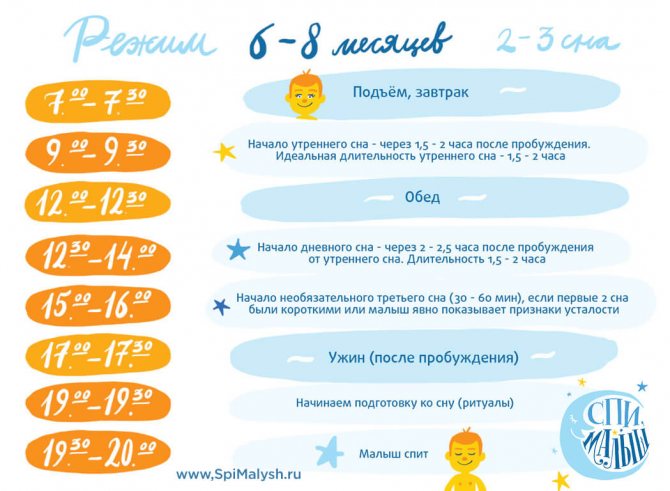
Video lesson How long should a child sleep? Subscribe to our YouTube channel so you don't miss new videos!
Mode Early Bedtime Daytime Sleep Frequent Waking up
FoodSleep NormalSleep TimeWake ConditionsSleep RegressionSleep
Walk
Walking outside at least 2 times is required. On the street, a whole world opens up for the baby: people, nature, animals, cars and houses. Communicate more with your baby. He tries to babble and actively reacts to everything you show and tell him about.
- For safety reasons, be sure to buckle up your baby. Due to quite a lot of activity, he may simply fall out of the stroller.
- Children sleep well in the fresh air during the day. Therefore, try to combine your daytime nap with a walk in the park.
- If possible, spend more time in nature in the summer, where your baby can sit on the grass or touch a flower or leaf.
Features and changes in the baby’s daily routine
At 7 months, babies learn about the world around them, move a lot, crawl, play, and try to reproduce words and sounds. During this period, it is very important to accustom the child to a routine in order to program the body to perform certain actions at the same time. An approximate regimen for a child of 7 months is shown in the table.
| 06:00 | Getting up, first feeding. |
| 06:30-08:00 | Morning wakefulness: hygiene procedures, gymnastics, communication with adults, educational games. |
| 08:00-10:00 | Morning dream. It promotes proper digestion and prepares for further achievements. |
| 10:00-10:30 | Breakfast |
| 10:30-12:00 | Wakefulness: massage, exercise, active games. |
| 12:00 — 14:00 | Walk. Sleeping in the fresh air is very important for a baby: it strengthens the body and helps improve immunity. |
| 14:00 — 14:30 | Dinner |
| 14:30 — 16:00 | Wakefulness. This time can be spent playing games or simply letting the baby crawl and stretch, satisfy his curiosity and play with his favorite educational toys. |
| 16:00 — 18:00 | Daytime sleep. While the baby is still in need of additional breaks, during which the body accumulates strength. |
| 18:00 — 18:30 | Dinner |
| 18:30 — 20:00 | Wakefulness: communication with adults, inactive games. |
| 20:00 – 20:30 | Swimming, water procedures before bed |
| 20:30 – 21:00 | Fifth feeding, getting ready for bed |
| 21:00-06:00 | Night sleep |
You need to understand that some children spend their time actively and need only one day's rest, while others like to sleep and rest 2-3 times a day. Therefore, the table is approximate; each parent should create a daily routine taking into account the characteristics of the baby.
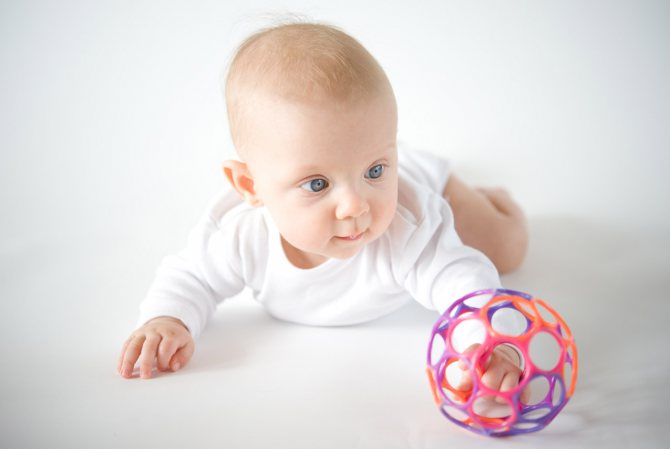
Recommendations
- The age of 7 months is one of the transitional stages in a child's life. Many people are getting their first teeth, their sleep time is shortening, so their daily routine may change and shift. This does not mean that it should not be adhered to at all. Parents are advised to adapt to the baby's needs and create a schedule.
- The main points remain good nutrition, timely and necessary hours of rest. During the warm season, combine a walk and a nap during the day.
- While awake, play various games with your kids that develop fine motor skills. Such games develop memory and attention.
- When bathing your baby in an adult bathtub, place a special mat on the bottom to prevent slipping. Add a watering can or bucket to your usual rubber toys. By pouring water, the child also develops finger motor skills.
- Proper organization of the daily routine gives a positive result. The child is active, cheerful, eats and sleeps well, and also develops faster than his peers.
Baby sleep norms
The age of 7 months clearly demonstrates the individuality of the body. Some children still require long periods of rest during the day. Other babies are already becoming physiologically ready for the transition to two naps a day during daylight hours.
They are more active, play longer, and get tired more slowly. Such children should be given rest from 11:00 to 12:30 and from 16:00 to 17:30. The total sleep duration of a seven-month-old baby can vary between 11-13 hours.

Rest standards for children aged 7 months:
- daytime sleep – 3.5-4.5 hours;
- night – 7.5-8.5 hours.
If a child has become more active and cannot fall asleep on schedule, this means that his period of wakefulness has begun to prevail over the duration of rest.
This is a completely normal phenomenon that indicates the development of the baby. In this case, it is worth making certain adjustments to the child’s daily routine. But you need to take into account the baby’s well-being and behavior.
It happens that a baby cannot sleep due to fatigue or discomfort or illness. If he is active, he is in a good mood, he quickly falls asleep after a certain period of wakefulness, then this means that a shorter rest is already enough for him.
Some children choose this regimen for themselves: they sleep for about 2-3 hours while walking outside, and rest for no more than an hour in the morning and evening. This is also a variant of the norm.
Some parents complain that the child gets used to falling asleep only on the street, and becomes capricious and cries when the mother tries to put him to sleep at home. To solve this problem, it is necessary to review the schedule and organize walks during the baby’s active period.
The following indicates that your sleep schedule is correct:
- the child falls asleep quickly and without hysterics;
- During periods of wakefulness, the baby looks rested, energetic and cheerful.









